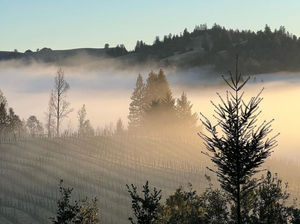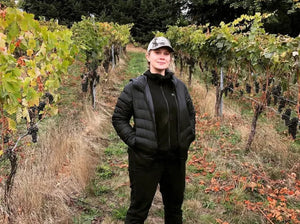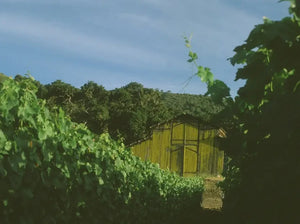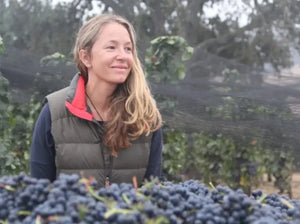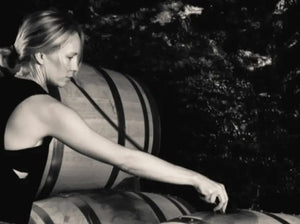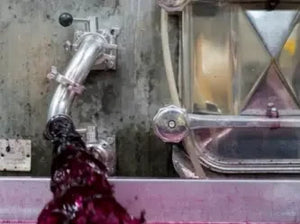Blog » California
-
Santa Cruz Mountains Maverick
I met Cole Thomas of Madson Wines at a 2019 tasting event highlighting "the new wave of Santa Cruz winemakers." Coincidentally, I was in town that weekend reporting on a story for SF Chronicle about four other young winemakers in the Santa Cruz region. I've been following Madson ever since, and I strongly believe that Thomas and his business partner, Ken Swegles, who also owns and runs a viticulture consulting firm, are among the next names to look to in the Santa Cruz Mountains.
Madson produces terroir-driven Chardonnay, Pinot Noir, and Syrah, three varieties that thrive in the cool, foggy climate here. The majority of vineyards in the region are small, a few acres at most, planted in small clearings vying with the rigid, mountainous landscape, redwoods, and forest.
Madson prioritizes leasing vineyards and overseeing its own farming instead of purchasing fruit. All of the vineyards they work with have been converted to organics, with an additional emphasis on regenerative farming. And to top it off, Swegles and his partner, Abbey Crystal, live on and farm Ascona Vineyard high up at 2,450 feet elevation. In the cellar, it’s natural and spontaneous fermentation, neutral wood, minimal racking, and just a small sulfur addition at bottling.
The Santa Cruz Mountains are considered an ideal place to grow Pinot Noir, and most of the AVA is planted to that. But Thomas says he is always looking for Chardonnay vineyards, and for our sake, I hope he finds them because these are the wines that Max and I are really excited about.
The Chardonnays featured here represent the two sides of the region (ocean vs. mountains). Toyon Vineyard is on a steep south-facing slope in the Soquel Hills; planted on sandstone soils just 400 feet above Monterey Bay, the vines nearly have a front-row seat to the Pacific’s coastal winds, morning fog, and cloud cover. And Les Enfants du Soleil comes mostly from 1960s-planted, own-rooted vines near Boulder Creek where the soil is decomposed schist. Both wines gracefully express cool-climate Chardonnay—fresh, vibrant, mineral—but Toyon has a prominent salinity component while Les Enfants du Soleil carries slightly more depth and concentration.
Both Thomas and Swegles have built their careers here in the Santa Cruz Mountains. After earning a degree in environmental studies at UC Santa Cruz and working a number of jobs in vegetable farming and landscaping, Thomas discovered winemaking while working for local legend, Jeff Emery of Santa Cruz Mountain Vineyard, where he also met and worked with Swegles. Together, they launched Madson Wines in 2018. -
Razor's Edge Last Dance: Enfield's Haynes Old Vine ChardonnayJohn Lockwood's 2015 Haynes Vineyard Chardonnay was one of the most memorable California wines ever tasted. 2021 is the last vintage John worked with this revered old vine section of the iconic Haynes Vineyard.Sommeliers have blinded it as Pierre-Yves Colin-Morey Meursault. When tasting, descriptors like "laser," "weightless," and "palate-staining" flood the mind.Haynes, located in Napa's coolest AVA, Coombsville, is home to a special parcel of 55-year-old Chardonnay vines. These same vines were the source of John Kongsgaard's early work with the seminal Newton "Unfiltered" Chardonnay of the 1970s. Lockwood had sourced from Haynes since 2010, but it wasn't until 2015 that he got to work with this prized, old vine parcel.The magic of these vines isn't just in the obvious concentration but rather a story of soil. Haynes is famous for its very high pH, powdery white volcanic ash subsoil, endowing wines with wild acidity that are rare in this region, where ripeness is never shy. The younger vines John had previously worked with here had shallower root systems that only tapped into the alluvial gravel topsoil. When the change was made to the old vine parcel in 2015, the real magic of this fascinating subsoil came to fruition.John and I met while working at Failla Wines in 2011. From a solar-powered cabin on the extreme Sonoma Coast, four of us organically farmed the Failla Estate Vineyard, home to Chardonnay, Pinot Noir, and Syrah.Getting to know John in tight quarters and amongst vine rows was a never-ending exploration into all things wine. Early mornings and late nights, the discussions never ceased. It was clear immediately that his thirst for discovery would be the root of all future accomplishments––well documented by the New York Times.For me, finding white wines in California that are built upon their focus and agility is the ultimate rarity since ripe forward fruit is ubiquitous. This wine has a head-spinning level of refinement and incisiveness that will appeal to every single white Burgundy lover.
-
Sta. Rita Sensation: 2016 Sandhi Blanc de BlancsValue aside ($36), Sandhi's 2016 Blanc de Blancs is the most delicious sparkling wine produced in America today. Full stop. While certainly not defined by the classic category mold's citrus and green apple notes, this 100% Chardonnay is analogous to drinking 20-year-old champagne in its prime with a sprinkle of hazelnut. Deep golden fruit with faint, waxy butterscotch tones and a finish that puts the exclamation point on the fact this is the apex of what extended-aged California sparkling wine can do.Sashi Moorman and Rajat Parr's 2016 was sourced from arguably the central coast's most heralded single plot of vines––own-rooted, 1971-planted Sanford & Benedict Chardonnay. After fermentation in neutral oak, the wine spent forty months sur lie (on the lees) in bottle with zero dosage. Then, five years aging in bottle post-disgorgement in the Sandhi cellars of Lompoc.When we tasted it, I was sure the price for such a multidimensional sparkler with so much aging would be around $80. I was shocked to learn we could offer single bottles at just $36. Our initial holiday offer sold out quickly, and we don't expect the modest quantity today to last long.
-
Hirsch Quake: A Record-Breaking VintageFor the first time, the iconic Hirsch Vineyards has allocated the release of their flagship San Andreas Fault Pinot Noir ($78). And it's no surprise why. 2021 marks not only the most successful vintage for Sonoma Pinot Noir in the 21st century but also the best-ever bottling of this wine.
Hirsch sits half a mile from the San Andreas Fault line. With 34 vineyard blocks comprising the eponymous cuvée, this signature blend is the ultimate snapshot of place. As David Hirsch notes, the fragmentation is unmatched even by the famously subdivided vineyards of Burgundy’s Côte de Nuits. The result is a wine exploding with fresh red cherry, strawberry, and mint notes that segue into a precise finish with dark chocolate, orange skin, and dusty minerality.Driving the winding road from downtown Sonoma to the property at the far edge of California’s coast is a rite of passage. I was lucky enough to work one ridgeline over at Failla’s Estate Vineyard, and I can tell you, despite the acclaim of the Pinot Noirs, the extreme Sonoma Coast’s rugged terrain remains built for a few. David was the first to plant Pinot Noir here in 1980, and the location remains completely remote.Producing wines of consistent ripeness and grace in a marginal climate like this one is no easy feat, especially when the grapes are known for having formidable tannins. And yet, that is precisely the tall task that daughter Jasmine Hirsch and Consulting Winemaker Michael Cruse have accomplished.
The style has changed throughout the last twenty years since David built a winery and began putting Hirsch Vineyards on his own label. Today, they have opted for 100% de-stemming across the board and about 30% new oak for this particular cuvée. Again, 2021 is the most successful version of Hirsch’s San Andreas Fault Pinot Noir, and in a vintage where the entire lineup has received “perfect” praise. -
Inconnu: California Cabernet Game-Changer
There are U.S. trailblazers, and there are game-changers, but you rarely find both under one roof. Laura Brennan Bissell's appropriately named label Inconnu, meaning "unknown," is the 2023 discovery that had me feeling, well, seen.
I generally drink Cabernet Sauvignon from Bordeaux, Santa Cruz Mountains, and Napa/Sonoma. But I only pull those corks when the menu calls for steak or lamb. Simply put, you won't find me watching a David Lynch flick with a glass of Cab––I don't have the interest to imbibe for 2 hours sans food. And that is why Inconnu is as invigorating a game-changer as I've tasted from California in a long time.
Bissell's wines all carry modest alcohol levels (well below what that even means in the regions above), and they have such beautiful balance and finesse that they disappear fast but offer long-lasting joy. They marry the refreshing qualities of a great Cru Beaujolais with the flavor profiles of ripe-not-overripe Cabernet Sauvignon, where black cherries and currants can be found with notes of eucalyptus and mint that make things a lot more exciting––and delicious!
Another thing that makes clear these wines were destined to be KWM mainstays is their origin, coming from the same distributor/importer as Clos Rougeard, COS, Soldera, Roagna, and Duroché, to name a handful). At the portfolio tasting last month, I was taken by how each red, regardless of their modest pricing, stood toe-to-toe with one another. I went back multiple times for tastes and was still hard-pressed to pick a favorite––they were all endowed with the kind of grace and intensity that separates the good from the great.
Do not miss these GREAT California reds that check all the boxes for Old World wine lovers and "New California" enthusiasts. And don't miss the crystalline Chenin Blanc from old vines in Clarksburg! -
Sta. Rita Hills Sensation: Sandhi Blanc de Blancs
Value aside, Sandhi's 2016 Blanc de Blancs ($36) is the most delicious sparkling wine produced in America today. Full stop. While certainly not defined by citrus and green apple notes of the classic category mold, this 100% Chardonnay is analogous to drinking 20-year-old champagne in its prime with a sprinkle of hazelnut. Deep golden fruit with faint, waxy butterscotch tones and a finish that puts the exclamation point on the fact this is the apex of what extended-aged California sparkling wine can do.
Sashi Moorman and Rajat Parr's 2016 was sourced from arguably the central coast's most heralded single plot of vines––own-rooted, 1971-planted Sanford & Benedict Chardonnay. After fermentation in neutral oak, the wine spent forty months sur lie (on the lees) in bottle with zero dosage. Then, five years aging in bottle post-disgorgement in the Sandhi cellars of Lompoc.
When we tasted it, I was sure the price for such a multidimensional sparkler with so much aging would be around $80. I was shocked to learn we could offer single bottles at just $36. With holiday season in full bloom, this wine leaves the most significant impact at the most palatable price. Do not miss it! -
Angela's Ethereal Grenache: A Tribute to GraceSanta Barbara County is producing some of the most thought-provoking and impressive wines in the U.S. If a sense of place is what we're after, Angela Osborne's Grenache-focused label, A Tribute to Grace, is a great place for the exploration to start.
Working closely with Angela during my time at Failla Wines, in 2011, I remember the first time she poured the Santa Barbara Highlands Vineyard Grenache for our crew, and the enthusiasm that followed. With partial whole cluster fermentation and minimal new oak, the wines are light on their feet and showcase all of the delicacy that Grenache is capable of but rarely achieves in California.
Angela grew up in New Zealand, and upon tasting the greatest expression of Grenache in the world, Chateau Rayas, set out to find the perfect terroir to produce a Grenache-focused label. Angela's grandmother, named Grace, was an equally forceful inspiration toward her landing in California. As terrific as these wines are, knowing the kind person crafting them makes the appeal even greater. -
Timeless Napa Cabernet: Diana Snowden
Finding jaw-dropping hillside vineyards beyond each weave and turn of Napa Valley's roads is common. However, finding winemakers that live up to the landscape by pursuing graceful, nuanced, and site-specific wines is more of a challenge. Diana Snowden Seysess typifies this essence like few others in the valley do, and the winery's history explains why the personification of place is her ultimate intent.
Snowden eschews many winemaking practices that have become commonplace today. No cultured yeasts are employed, no enzymes to enhance color, no "bleeding" of the must for concentration, no fining, and no sterile filtration. Diana presses off the skins when they're dry rather than ongoing maceration to pick up more density and extraction. The wines never see more than 50% new French oak.The Snowden Ranch began in 1878 after the Homestead Act encouraged the settlement of new agricultural lands in the valley. The Snowden family took control of these vineyards in 1955, planting different parcels of Cabernet Sauvignon. Through the 1980s, the family worked closely with Warren Winiarski of Stags Leap Cellars to improve their vineyards. Finally, Snowden Vineyards produced its first wines from the family estate in 1993.
Diana grew up in Napa Valley and graduated from the UC Davis Viticulture and Enology program. In 2003, she became the oenologist at Domaine Dujac and worked alongside her now-husband, Jeremy Seysses, crafting some of Burgundy's most celebrated wines. Her time between Napa and Burgundy brings extraordinary perspective. These wines re-shape how Napa Valley speaks to sense of place. -
Quintessential California Syrah: Piedrasassi
Santa Barbara's cool-climate wines have growingly become one of my obsessions. For me, the most integral name in the array of labels is Sashi Moorman. His Pinot Noir, Chardonnay, and Gamay are among my favorites, but his first label, Piedrasassi, offers downright delicious and complex reflections of Syrah.
Piedrasassi harnesses savory, bright, and superior aromatics while never shying away from the innately luscious qualities that define California Syrah. They nail the roasted meat, violet, and black pepper trifecta at each price point. The P.S. bottling, sourced from a handful of Piedrasassi's single vineyards, is the perfect introduction to their philosophy on cool-climate Syrah, and the vineyard-designate bottlings best exemplify how these wines continually develop in bottle over many years.
Sashi vinifies and ages as naturally as possible, excluding sulfur at fermentation and only utilizing native yeasts. Whole cluster inclusion and aging in larger 500-liter barrels ensure the lively, crushed rock virtues that make Northern Rhone Syrah so unique aren't lost here in Santa Barbara.
.svg?v=162776257677185172071724397232)






